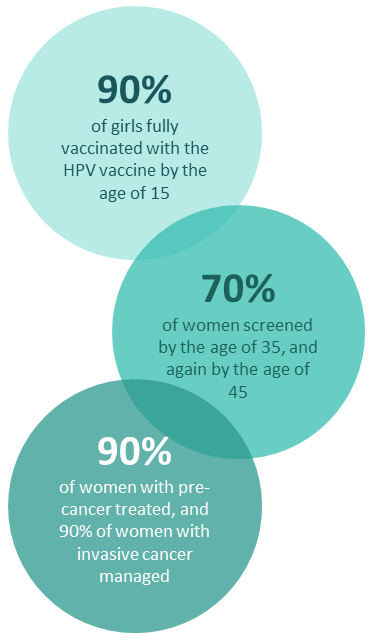The WHO’s cervical cancer elimination goal
Courtesy of I-TECH (International Training and Education Center for Health)
90-70-90 targets must be met by 2030 to eliminate cervical cancer
Cancer is one of the leading causes of death worldwide and second after heart disease in the United States. The emotional and physical suffering inflicted by cancer is even more harrowing than death. Patients and the public often ask, “when will there be a cure for this affliction?” The answer, at least for cervical cancer, is within reach.
An estimated 570,000 women are diagnosed with cervical cancer worldwide, and about half die from it. Unfortunately, more than 85% of these deaths occur in low and middle-income countries. Public awareness and organized pap screening programs to detect cervical cancer have dramatically reduced this burden in the US. Most cervical cancer cases (99%) are linked to infection with high-risk human papillomaviruses (HPV), a ubiquitous virus transmitted through sexual contact. Although most infections with HPV resolve spontaneously, persistent infection can cause cervical cancer in women over some time. By pap smear screening, health care workers can detect the pre-cancerous stage and successfully treat it. Cancers diagnosed in late stages can be challenging and require more sophisticated treatment modalities.
In 2019, recognizing the enormity of the cervical cancer problem, the Director-General of the World Health Organization (WHO) announced a global call to action toward eliminating cervical cancer, “underscoring renewed political will to make elimination a reality and calling for all stakeholders to unite behind this common goal.”
The WHO’s strategy to eliminate cervical cancer, known as triple intervention, aims to achieve 90-70-90 targets that must be met by 2030. The 90-70-90 targets are as follows: vaccinations—90% of girls are fully vaccinated with the HPV vaccine by age 15, screening—70% of women to be screened with a high-performance test by 35 years of age and again by 45 years of age and treatment—90% of women identified with the cervical disease receive treatment (90% of women with pre-cancer treated and 90% of women with invasive cancer managed). The benefits of achieving this triple target are reflected by the staggering number of preventable deaths estimated by WHO; the median cumulative number of cervical cancer deaths averted will be 300,000 by 2030, over 14 million by 2070 and over 62 million by 2120.
The way to meet the WHO objective of eliminating cervical cancer is to roll out HPV vaccines across the globe for girls under 15. Numerous barriers, including lack of knowledge, sociocultural factors and vaccine costs, prevent the low and middle-income countries from achieving the triple target by 2030. Widespread public awareness campaigns to overcome the barriers and generous financial aid with access to the HPV vaccine in low and middle-income countries are the need of the hour to make the WHO initiative succeed. Alternative cost-effective screening measures like HPV DNA testing and “see & treat” approaches must be explored as they can replace the skilled labor to reach the target of 70%. Simultaneously, training and investment in tertiary care centers should be encouraged to treat screen-detected early-stage and late-stage cancers.
By implementing the WHO’s ambitious, concerted and inclusive strategy by each country to meet the 90-70-90 targets, we are on the path to eliminating cervical cancer within the next century.


